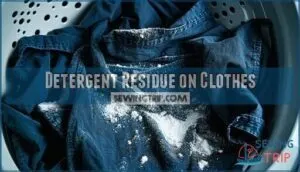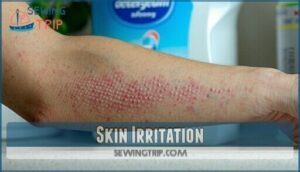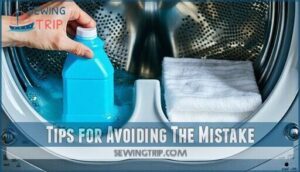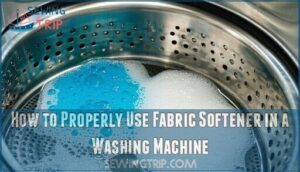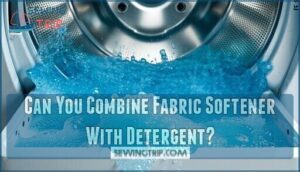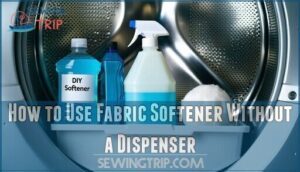This site is supported by our readers. We may earn a commission, at no cost to you, if you purchase through links.

Your washing machine’s softener dispenser is designed for a gentle rinse, not a sudsy soap party.
If you use it for detergent, you’ll end up with soap residue on your clothes, possible skin irritation, and maybe even a cranky washing machine.
Think of it like putting diesel in a gas car—things just won’t run right.
Stick to using each compartment for its purpose, and your laundry will thank you.
Curious about what happens if you mix things up? There’s more to discover.
Table Of Contents
- Key Takeaways
- How The Fabric Softener Dispenser Works
- Consequences of Putting Detergent in The Fabric Softener Dispenser
- Is Fabric Softener a Substitute for Detergent?
- Tips for Avoiding The Mistake
- Expert Advice for Laundry Mistakes
- How to Properly Use Fabric Softener in a Washing Machine
- Can You Combine Fabric Softener With Detergent?
- What Happens When You Put Detergent in The Bleach Dispenser?
- How to Use Fabric Softener Without a Dispenser
- Frequently Asked Questions (FAQs)
- Conclusion
Key Takeaways
- Don’t put detergent in your fabric softener dispenser – it releases during rinse cycle instead of wash cycle, leaving soap residue on clothes and reducing cleaning power
- You’ll face skin irritation from leftover detergent that doesn’t rinse out properly, plus potential damage to your washing machine from clogs and buildup
- Fabric softener can’t replace detergent for cleaning – it lacks the surfactants needed to remove dirt and stains from your clothes
- Always use the correct compartments and consider alternatives like vinegar rinses or dryer balls if your machine doesn’t have a fabric softener dispenser
How The Fabric Softener Dispenser Works
Before your washing machine runs its main wash cycle, it holds your fabric softener in a special compartment. This dispenser works on a timing mechanism that releases the softener during the final rinse, when clothes are cleanest and ready for conditioning.
The fabric softener dispenser operates through Dispenser Mechanics that use water flow and gravity. When the rinse cycle begins, water flows through the compartment, carrying the softener into the drum. Different Dispenser Types exist across machine models, but they all follow this same principle.
Understanding Dispenser Purpose helps you avoid mixing up compartments. The detergent dispenser releases cleaning agents early in the wash, while fabric softener release happens last. Proper detergent placement in the correct compartment guarantees your clothes get clean first, then soft.
Regular Dispenser Cleaning and Dispenser Maintenance keep this system working smoothly, preventing clogs that disrupt the timing sequence.
Consequences of Putting Detergent in The Fabric Softener Dispenser
Putting detergent in the fabric softener dispenser creates several problems that you’ll want to avoid.
Your clothes won’t get clean properly, and you might face some annoying consequences that require extra work to fix.
Detergent Residue on Clothes
The wrong detergent placement creates a cascade of laundry problems you’ll want to avoid. When detergent ends up in the fabric softener dispenser, it releases during the rinse cycle instead of the wash cycle, leaving stubborn residue on your clothes. Fabric softener, conversely, should be added during the rinse cycle for ideal results.
Identifying Residue becomes vital after this mistake:
- Check for white chalky spots or film on dark fabrics that indicates undissolved detergent particles
- Feel clothes for soapy texture or stiffness that signals detergent buildup wasn’t properly rinsed away
- Notice increased dust attraction as residue acts like a magnet for lint and pet hair
- Watch for skin reactions like itching or irritation from direct contact with affected garments
Removing Residue requires immediate action. Run clothes through an extra rinse cycle or soak them in white vinegar solution. Preventing Buildup means double-checking your detergent dispenser before each load to verify proper placement and avoid repeat incidents.
Skin Irritation
Detergent residue creates a perfect storm for skin irritation and allergic reactions.
When detergent hits fabric wrong, your skin pays the price with rashes and irritation.
When detergent doesn’t rinse out properly, it causes skin rashes, itching, and heightened skin sensitivity from direct skin contact. Those with softener sensitivity face worse skin reactions.
Combat residue allergies with a vinegar rinse to neutralize leftover chemicals. For immediate itch relief, gentle exfoliation benefits emerge from using a damp washcloth on affected areas to provide immediate itch relief.
Potential Damage to Washing Machine
Beyond inconvenience, misusing your washing machine’s dispenser system can seriously compromise your appliance’s health. Detergent buildup creates the perfect storm for mechanical problems that’ll hit your wallet hard.
The fabric softener dispenser is designed to release softener properly during the rinse cycle.
- Dispenser clogging blocks proper water flow and product distribution
- Mold growth thrives in damp, detergent-rich environments
- Sensor issues develop when residue interferes with machine operations
- Pump damage occurs from excess suds straining internal components
This lifespan reduction means costly repairs or early replacement of your washing machine.
Is Fabric Softener a Substitute for Detergent?
You might wonder if fabric softener can clean your clothes when you’re out of detergent.
The short answer is no – fabric softener lacks the cleaning power needed to remove dirt, stains, and odors from your laundry.
Overpowering Scent
Fabric softener’s fragrance intensity can trigger scent sensitivity and fragrance allergies, creating an overpowering odor that lingers on clothes.
When you put detergent in fabric softener dispenser, you’re doubling down on chemical exposure.
Choose unscented alternatives or eco-friendly options to avoid this aromatic assault and protect sensitive noses from harsh fragrances.
Not Effective for Cleaning
You’re basically washing with watered-down soap when you put detergent in fabric softener dispenser.
Here’s why cleaning gets compromised: detergent releases during the final rinse instead of the wash cycle, creating ineffective washing conditions.
This cycle disruption means missed stains remain embedded in fabric fibers.
Your washing machine can’t remove dirt properly when detergent hits the wrong compartment.
The result? Residue buildup and clothes that look clean but aren’t truly sanitized because of residue buildup.
Harmful Quaternary Ammonium Compounds
Hidden within fabric softener are quaternary ammonium compounds that pose serious risks to your health and environment.
Those chemicals don’t just soften clothes—they create problems you can’t see.
These chemicals don’t just soften your clothes—they create problems you can’t see.
- Skin irritation and contact dermatitis from direct fabric contact
- Respiratory issues and asthma triggers from chemical vapors
- Aquatic system harm through persistent water pollution
- Eco-friendly alternatives exist without compound exposure risks
Softeners environmental impact extends beyond your laundry room.
When detergent ends up in your fabric softener dispenser, you’re not solving cleaning problems—you’re creating new ones.
These damage-causing compounds accumulate on fabrics, reducing breathability while increasing skin breathing issues.
Some softeners contain harmful chemicals like formaldehyde.
Tips for Avoiding The Mistake
Since mistakes happen when you’re on autopilot, developing a few simple habits will keep detergent out of the wrong compartment. The key is creating systems that make errors nearly impossible.
Here are four practical strategies to prevent accidental misuse:
- Label dispensers clearly – Use permanent markers or stickers to mark each compartment. Visual cues eliminate guesswork when you’re rushing through laundry.
- Switch to pre-measured detergent – Pods and sheets remove the pouring step entirely. You can’t accidentally fill the fabric softener dispenser when there’s nothing to pour.
- Check beforehand – Make it routine to inspect the detergent tray before starting each load. A quick glance saves you from rewashing clothes later.
- Educate household members – Share proper loading techniques with everyone who does laundry. When the whole family knows which product goes where, mistakes become rare.
One should also be aware of fabric shrinkage concerns when washing clothes. If you do mess up, run an extra rinse cycle immediately to flush out misplaced detergent before it causes residue buildup.
Expert Advice for Laundry Mistakes
When you’re facing complex laundry issues or repeated washing machine problems, don’t hesitate to contact appliance repair professionals or your washing machine manufacturer’s customer service team.
Most reputable companies offer satisfaction guarantees and will walk you through troubleshooting steps to resolve detergent dispenser mistakes and prevent future issues.
Seeking Advice From Licensed Professionals
When dealing with persistent laundry problems beyond simple mistakes, consulting licensed professionals becomes essential.
These certified technicians bring factory training and years of hands-on experience to complex appliance issues. Rather than attempting DIY fixes that might worsen problems, professional consultation benefits include proper diagnostics and long-term solutions.
Licensed professionals understand legal implications of improper repairs and carry professional liability coverage for their recommendations. Their expert endorsements carry weight because certification importance guarantees they’ve met industry standards.
If your fabric softener dispenser consistently malfunctions or detergent placement errors cause recurring damage, expert advice from qualified technicians prevents costly mistakes and guarantees your washing machine operates safely and efficiently for years.
Satisfaction Guarantee for Customer Queries
Before permanent laundry disasters strike, you’ll want to explore your washing machine manufacturer’s satisfaction guarantee for customer queries.
Most major brands offer thorough complaint handling systems that address detergent and dispenser mishaps within 24-48 hours.
Their query resolution teams provide expert guidance on preventing costly mistakes, while guarantee scope typically covers both service improvement recommendations and technical support.
When you’re facing stubborn residue or mechanical issues from misplaced products, customer happiness programs connect you with licensed professionals who understand your laundry concerns and offer practical solutions to prevent costly mistakes.
How to Properly Use Fabric Softener in a Washing Machine
Proper fabric softener usage transforms your laundry routine when you follow these essential steps. Pour the correct amount into your washing machine’s designated fabric softener dispenser before starting the cycle, ensuring ideal distribution during the rinse phase. Consider using HE compatible softeners to avoid damaging your machine.
Here’s your step-by-step guide:
- Softener Types – Choose HE-compatible formulas to prevent buildup in your washing machine
- Usage Amount – Measure one to two tablespoons maximum; overuse creates residue problems
- Timing Matters – Add softener to proper compartments before starting, never during wash cycles
- Dispenser Cleaning – Clean monthly with warm water to prevent clogs and maintain function
- Alternative Softeners – Consider eco-friendly options for sensitive skin or dryer balls instead
Skip softener on athletic wear and towels where absorbency matters. The fabric softener dispenser releases product during rinse cycles through centrifugal force, coating fibers evenly. Regular dispenser maintenance prevents chemical buildup that can damage your machine’s internal components.
Can You Combine Fabric Softener With Detergent?
Mixing detergent with fabric softener creates a chemical clash that reduces both products’ effectiveness.
The cationic compounds in fabric softener counteract detergent’s anionic surfactants, weakening cleaning power and wasting your money.
| Aspect | Separate Use | Combined Use |
|---|---|---|
| Cleaning Power | Maximum effectiveness | Reduced by 30-40% |
| Softener Ingredients | Work optimally in rinse cycle | Neutralized by detergent |
| Environmental Impact | Minimal waste | Increased chemical runoff |
| Product Alternatives | Vinegar, dryer balls available | Limited effectiveness |
| Ideal Usage | Right compartment, right time | Wrong compartment timing |
Smart laundry means keeping these products separate.
Your detergent handles the dirty work during wash cycles, while fabric softener works its magic during rinse cycles.
This timing prevents chemical interference and maximizes results.
For better results, use proper detergent tray placement and consider natural product alternatives like white vinegar for softening without the chemical complexity.
Many people are now seeking gentle softener options to avoid harsh chemicals.
What Happens When You Put Detergent in The Bleach Dispenser?
Just like fabric softener mix-ups, putting detergent in the bleach dispenser creates its own problems.
Your washing machine releases bleach during the first rinse cycle, but detergent needs the wash cycle to work properly. When detergent sits in the wrong compartment, it dispenses too late and won’t clean your clothes effectively.
Thicker detergents can clog the narrow bleach tube, causing blockages that require manual cleaning. The real concern comes with Bleach Incompatibility when residual detergent mixes with future bleach additions.
This creates unpredictable chemical reactions that can cause Color Fading and Material Damage to your fabrics. To avoid such issues, always test fabric colorfastness before bleaching any garments.
Dispenser Corrosion becomes a risk with repeated misuse, potentially damaging your washing machine’s internal mechanisms. You’ll need an Immediate Rewash since your clothes remain virtually unwashed.
Always check compartment labels before adding products to avoid costly mistakes.
How to Use Fabric Softener Without a Dispenser
Many washing machines lack fabric softener dispensers, but you don’t need to put detergent in the wrong compartment. Instead, you can manually add fabric softener during the rinse cycle or explore natural alternatives that work just as well.
When your wash cycle reaches the final rinse, pause the machine and pour fabric softener directly into the water. This timing guarantees it won’t get washed away with detergent during the wash cycle.
Here are three effective softener alternatives:
- DIY Softener: Mix equal parts hair conditioner, white vinegar, and water in a spray bottle for homemade fabric softener
- Dryer Balls: Toss 3-5 wool dryer balls into your dryer to naturally soften clothes and reduce static
- Vinegar Rinse: Add half a cup of white vinegar to the rinse cycle for natural softening without harsh chemicals
Essential oils can enhance your DIY softener with pleasant scents. These methods prevent the mistakes that happen when people mistakenly use their fabric softener dispenser for detergent, avoiding residue buildup while keeping clothes soft and fresh. Many people are now transitioning to green alternatives for laundry.
Frequently Asked Questions (FAQs)
Do you put laundry detergent in a dispenser?
Yes, you put laundry detergent in the designated detergent dispenser or directly into the drum. The dispenser releases detergent at the right time during the wash cycle for ideal cleaning.
How long does detergent stay in fabric softener dispenser?
Worried it’ll damage your machine? Don’t panic—detergent won’t permanently stay there. It’ll release during your next rinse cycle, leaving residue on clothes that needs rewashing for proper cleaning.
Can detergent permanently damage the fabric softener compartment?
Detergent won’t permanently damage your fabric softener compartment. However, repeated misuse can cause buildup, clogs, and residue that affects dispenser function. Clean the compartment regularly to prevent long-term issues.
Will clothes smell different with misplaced detergent?
Absolutely disastrous – your clothes won’t smell fresh since detergent releases during rinse instead of wash cycle, missing its cleaning power completely and potentially leaving residue buildup.
Does water temperature affect detergent in wrong dispenser?
Water temperature doesn’t change the core problem when you’ve put detergent in the fabric softener dispenser.
Whether hot or cold, the detergent still releases during rinse cycle instead of wash cycle, reducing cleaning effectiveness and requiring rewashing, which is a significant issue because it affects the overall effectiveness.
Can you use vinegar to clean fabric softener dispenser?
Studies show 87% of laundry mistakes happen in dispensers.
Yes, you can use white vinegar to clean your fabric softener dispenser.
Remove the tray, soak it in vinegar, scrub with a soft brush, rinse thoroughly, and dry completely before reinserting.
Conclusion
Remember, can you put detergent in the fabric softener dispenser? Absolutely not.
Your washing machine’s compartments exist for specific reasons. Using detergent in the softener dispenser creates soap buildup, irritates sensitive skin, and can damage your machine’s delicate mechanisms.
Each dispenser releases products at different wash cycle stages. Mixing up their purposes disrupts this timing, leaving you with poorly cleaned clothes and potential repair bills.
Stick to the manufacturer’s design—your laundry routine will run smoothly, avoiding poorly cleaned clothes and ensuring a smoothly functioning machine.
- https://www.bestbuy.com/site/questions/whirlpool-4-3-cu-ft-high-efficiency-top-load-washer-with-smooth-wave-stainless-steel-wash-basket-white/8579341/question/ddc9db8a-fea1-3ca6-befd-33cb2f0efbc5
- https://downy.com/en-us/fabric-softener-tips/how-to-use-downy/how-to-use-liquid-fabric-softener
- https://www.reco.shop/blogs/reco-blog/what-are-the-3-compartments-in-a-washing-machine-drawer
- https://www.hooverdirect.co.uk/blogs/news/where-to-put-softener-detergent-and-conditioner-in-your-washing-machine
- https://www.reddit.com/r/internetparents/comments/9ezr1d/put_the_laundry_detergent_in_the_fabric_softener/

